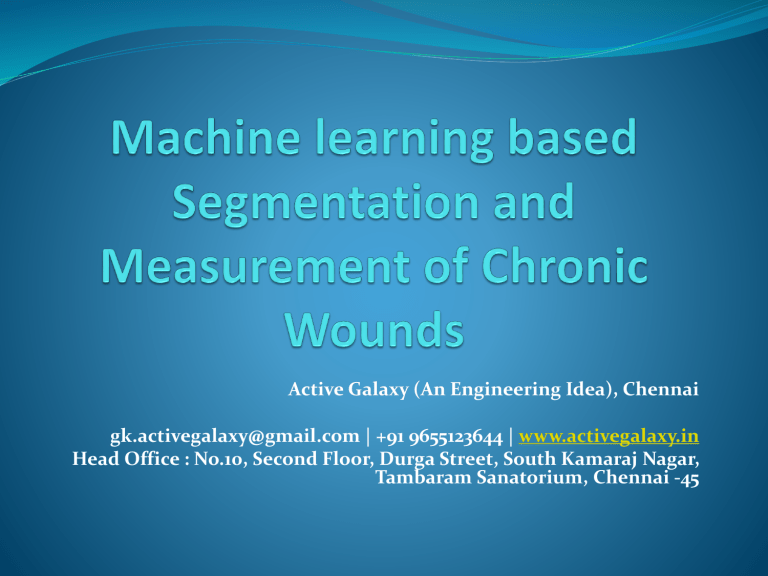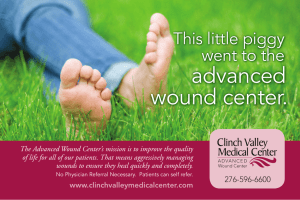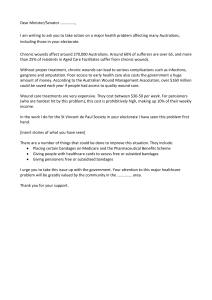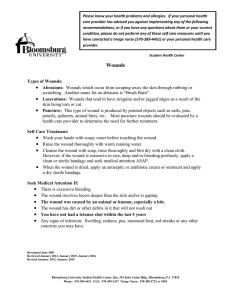Machine learning based Segmentation and Measurement of Chronic Wounds
advertisement

Active Galaxy (An Engineering Idea), Chennai gk.activegalaxy@gmail.com | +91 9655123644 | www.activegalaxy.in Head Office : No.10, Second Floor, Durga Street, South Kamaraj Nagar, Tambaram Sanatorium, Chennai -45 AIM This work aims to propose a new method to segment and classify tissues present in chronic wounds (granulation, necrosis and slough). Chronic wounds are ulcers with a difficult or nearly interrupted cicatrization process, like Pressure Ulcers (PUs), Venous Leg Ulcers (VLUs) and Diabetic Foot Ulcers (DFUs) in humans. Chronic wounds increase the risk of complications in health and well-being of patients, like amputation and infections, and affect an estimated 6.5 million people (2% of the population) in the United State. Those wounds related to diabetes resulted in approximately 73,000 lower limb amputations in 2010. They costed $174 billions to the United States in 2007, where $116 billion were in direct costs and $58.3 billion in indirect costs, such as loss of productivity, disability, and premature mortality. Chronic wounds incidence tend to increase due to the aging population and more incidence of risk factors such as diabetes and obesity. MOTIVATION The main motivation for this work is its use in a smart system that will allow health professionals to accurately compute the necrotic areas of an ulcer in order to determine the optimal number of larvae needed to clean it. Our machine learning proposal should be able to: Segment wound area Classify wound tissues Calculate wound tissues areas in cm2 Objectives Proper application of Larval Therapy requires tissue area calculation in wound to avoid waste of larvae or to use of less larvae than necessary. The visual exam of the wound is a simple and very used method, although highly inaccurate. A somewhat more accurate alternative is the manual measurement of wounds height and width, but with inconvenience of being invasive. As wounds usually cover irregular shapes and surfaces, this still does not have a very good accuracy. Image processing and Computer Vision techniques can be a great aid to tissue area calculation of wounds during Larval Therapy, with the potential of producing results with better accuracies while using less health care professionals efforts and errors. Comparing methods of debridement EXISITNG SYSTEM To implement wound bio-printing, an accurate measurement of wound surface specifications is required. While contact measurement of wounds, e.g., ruler, wound tracing, and planimetry methods, are still widely used, these methods are generally slow, inaccurate, and often problematic. Thus, these limitations along with the need for high-speed methods for measuring different soft materials such as human body tissues, including the skin, have led to the emergence of noncontact fast measurement methods. Proposed system The machine learning based Full-automatic image segmentation method gives clinicians much higher control by providing more-efficient coordinates for bioprinting. We used completely biocompatible materials in providing cell printing platforms. Alginate-gelatin hydrogel was synthesized by dissolving 16% (w/v) sodium- alginate and 4% (w/v) gelatin in deionized water and, due to its desirable properties such as biocompatibility, low cost and an easy gelation process, was used as the biopolymer for cell encapsulation. The bioprinting results demonstrate 95.56% similarity between the bioprinted patch dimensions and the desired wound geometries, which represents a good match and overlap Proposed system REFERENCS 1) [1] K. Jung, S. Covington, C. Sen, M. Januszyk, R. Kirsner, G. Gurtner and N. Shah, “Rapid identification of slow healing wounds”, Wound Rep and Reg, vol. 24, no. 1, pp. 181-188, 2016. 2) A. Dababneh and I. Ozbolat, “Bioprinting Technology: A Current Stateof-the-Art Review”, J. of Manufacturing Science and Eng., vol. 136, no. 6, pp. 061016, 2014. 3) M. Bilgin and Ü. Güneş, “A Comparison of 3 Wound Measurement Techniques”, J. of Wound, Ostomy and Continence Nursing, vol. 40, no. 6, pp. 590-593, 2013. 4) A. Shah, C. Wollak and J. Shah, “Wound Measurement Techniques: Comparing the Use of Ruler Method, 2D Imaging and 3D Scanner”, J. of the American College of Clinical Wound Specialists, vol. 5, no. 3, pp. 52-57, 2013. 5) J. Thatcher, J. Squiers, S. Kanick, D. King, Y. Lu, Y. Wang, R. Mohan, E. Sellke and J. DiMaio, “Imaging Techniques for Clinical Burn Assessment with a Focus on Multispectral Imaging”, Advances in Wound Care, 2016.



